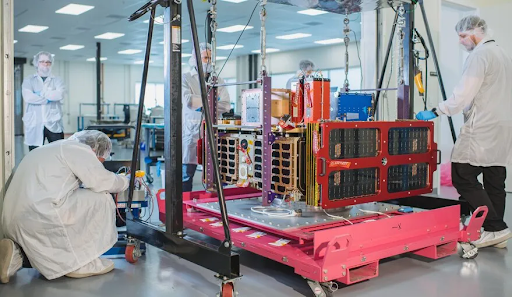In-n-Out v. McDonalds: Battle of the Burgers
Ba Da Ba Da Da, still hating it.
March 4, 2019
Fast food has become a major part of the American lifestyle, and this statistic is only increasing with new franchises and food chains. The US Center for Disease Control and Prevention (CDC) states that over 84.8 million adults consume fast food on any given day. Two of the most popular and well-known fast food chains in the Southwest, In-N-Out and McDonald’s, are said to make millions of dollars per day; however, the two have very different expectations from their customers. I had the opportunity to work at both restaurants, each for a little over a year, and came to understand why one is considered the top of the food chain while the other sinks low to the bottom in terms of quality, service, and benefits.
In-N-Out, a Christian, family-owned business, was started in 1948 with its first drive thru only restaurant in California. It has grown to populate five states, with just over 340 restaurants. In-N-Out is known for its high customer loyalty and has been rated one of the top fast food restaurants in several customer satisfaction surveys.
McDonald’s was founded in 1940, also starting in California as a small hamburger stand. McDonald’s states that they serve over 69 million customers a day in over 100 countries across over 39 thousand restaurants. McDonald’s is best known for their hamburgers and fries, and their iconic Golden Arches are always on the corner of every street.
Quality of food is one of the most essential parts of a great meal to any hungry customer; however, a lack of quality when comparing the two franchises is noticeable. In-N-Out has taken many precautions to ensure that customers are always receiving the best quality in terms of burgers and service. They have set in place strict rules as to how and when the food should be prepared, cooked, and served to their customers. For example, once an order has been taken, a tag or receipt is printed for the cooks and the customer with a timestamp. The timestamp makes it easier to keep in mind when the order was taken and approximate when the food will be ready. The cooks will often yell for a time; this is to keep themselves in check as to how long their burgers took from when they were ordered to when they were distributed.
The company has also implemented different milestones for the associates to allow them to work their way up to new levels, making sure no one will handle customer orders unless properly trained. There are seven levels, each with training videos, new skills to be learned, and a corresponding higher pay. These levels help to keep the quality of the product consistent by only allowing higher-level management to work in the process of preparing the food. For instance, only level 4 and up work at the fry table, and only levels 5 and up work at the grills and prep tables.
The food used is of an extremely high quality and the company makes sure nothing is ever frozen (there is only a walk-in fridge to store items that must be cooled) and the vegetables are organically farmed. Every morning, the food is thoroughly examined before the store opens to organize for ripeness and freshness. The food contains no pesticides and their tomatoes are said to only be used at In-N-Out franchises with a projected store price of over $6 per tomato. The In-N-Out company has a monthly quality check called QFC, where a representative from corporate that comes and checks the process of cooking, cleaning, and customer friendliness to set a score and determine where the store could improve.
Quality at McDonald’s was never a top priority, and probably never will be. As a new employee, you are barely, if at all, trained for how to properly prepare and deliver the food. In order to cook and prepare the main food (burgers, salads, and breakfast items), you have to be 16 or older, which was about their only filter for better quality. When the store was in a rush, the food was constantly thrown together, dropped, remade, or old, to make the process faster. When handling fries, no gloves were worn and the product was constantly falling on the floor, sometimes picked up and put back, other times pushed to the side to create messes on the ground. Almost all food was frozen, resulting in a loss of quality and moisture when thawing out. Many times, products such as cups, straws, and lids would be dropped or thrown away, and then reused as a way to “not go get more from the back.” The persistence of quality of product at McDonald’s is little to non-existent due to the lack of care and effort put toward making a more quality meal.
At In-N-Out, friendliness and customer service is the first priority of the company, and it definitely shows. Starting at In-N-Out, the first thing you are taught is to always have a smile, under the mandate of “Smile Checks,” no matter the time or situation. As a way to better interact with customers before, during, and after their meals, there is even a position as host in the dining room, often for lower level associates. This position spends their work shift with the customers, asking how their food is, opening doors, making conversation, getting refills, and attending to any additional customer needs. When addressing a customer, all associates must start with “Hi, how are you?” as a way to connect with customers and politely address any problems they may be experiencing.
McDonald’s customer service values are a bit different, and a lot less “customer friendly.” When first starting at the job, I was given no instruction as to how to interact with a customer and the pressure to make their experience memorable was little to none. When watching fellow employees take orders or hand out food, they often did not use a polite tone, smile, make eye contact, or were not there for the customer. This of course resulted in many, many complaints daily about quality of service and often resulted in miscommunication with food orders.
As for benefits, this was definitely one of the downfalls of being an In-N-Out associate. The company’s biggest benefit was their difference in pay, paying about $1.50 over the minimum wage, with a 25-cent pay increase with every level up. While on the job, each associate receives one free meal. This meal can include fries, a burger with two meats or less, and a water cup or hot chocolate. While their meals are always savory and delicious, for a company that makes millions of dollars daily, these benefits were a bit of a disappointment, and management had discussed it with us multiple times. Although, once a year during summer, the company rents out Wet-n-Wild for two days and every store in each state enjoys a free day with their friends and family with In-N-Out catering, games, and Wet-n-Wild equipment.
McDonald’s also had very few benefits for their employees. For every 6-plus hour shift, you received a free meal and pay is minimum wage. The free meal did not overcompensate for the treatment from staff and customers. It was definitely not enough to get through a shift with a smile on your face.
Working two very different fast food jobs allowed me to put into light how small differences like a simple smile and not using frozen food can make a huge impact on a customer’s meal. In-N-Out deserves their fame through all the hard work the company puts into making great experiences for each and every In-N-Out enthusiast. And, sure, drop by McDonald’s if you’d like, but be kind to the employees and don’t expect much from the food.








